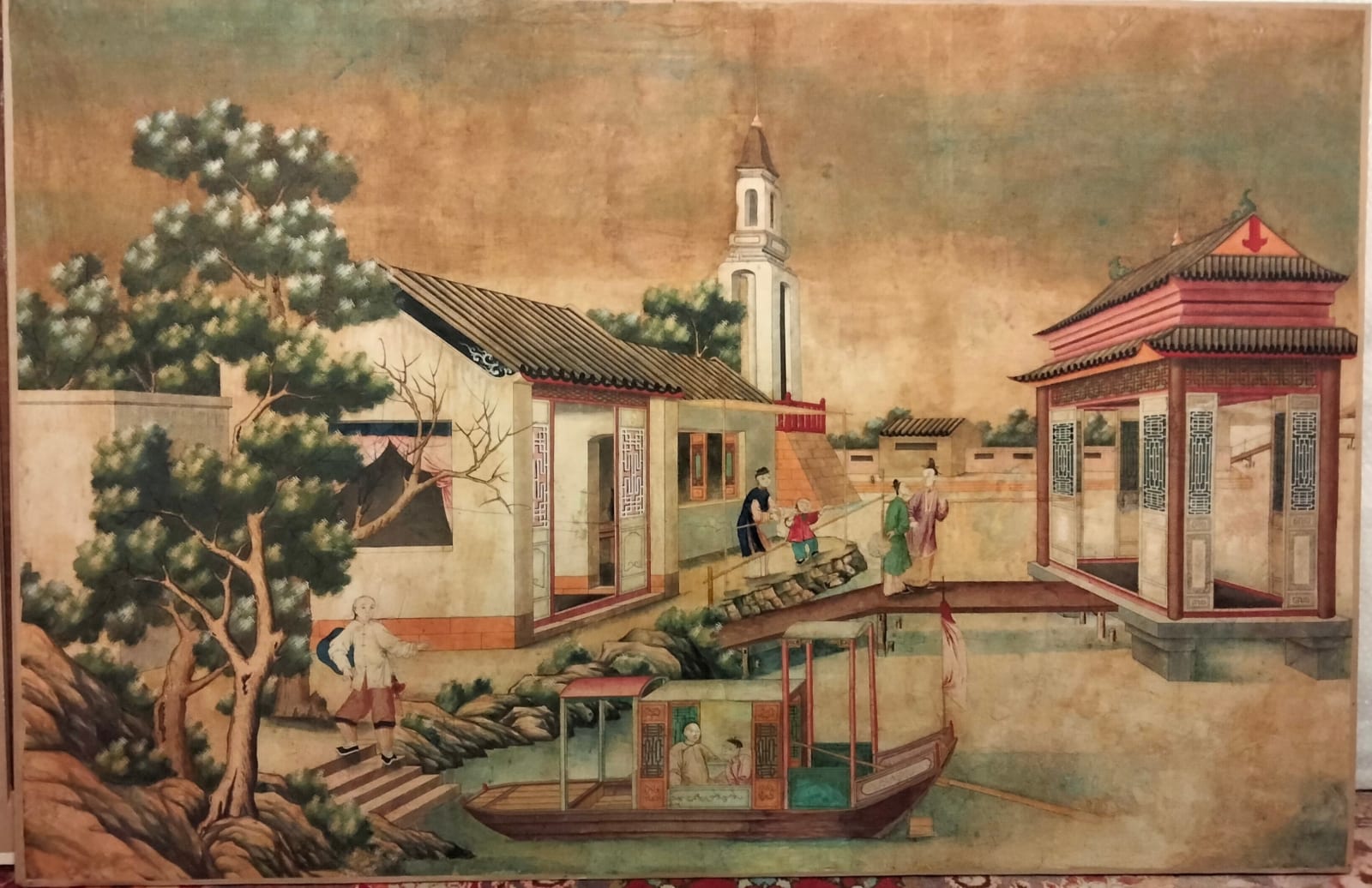Escola Chinesa
Pintura a guache sobre papel, do último quartel do seculo XVIII, proveniente da coleção dos Viscondes de Maiorca.
A composição centra-se numa paisagem fluvial onde se destaca uma residência, provavelmente de mandarim, com características típicas de arquitectura tradicional chinesa: telhado inclinado, com telhas onduladas e enrolamentos ornamentais pintados a branco nas extremidades, comuns em residências de classe média-alta.
A entrada da habitação é definida por dois painéis laterais, decorados com elementos em treliça, cobertos com tecido rosado. A janela da fachada tem padrão de meandros vermelhos e, a lateral, cortinas em cor-de-rosa.
No exterior, por debaixo de uma pérgula, uma serviçal de classe superior - provavelmente a ama da criança que a acompanha. Veste túnica comprida de tecido refinado e saia plissada longa, por debaixo de colete azul, com fendas laterais para facilitar os movimentos. O cabelo está adornado com alfinetes simples e usa brincos redondos. O menino, com tonsura manchú, veste calças e camisa verde e colete vermelho, com sapatos pretos de patim branco.
Ao lado da casa eleva-se uma “torre farol” ou de vigia,[1] estrategicamente posicionada, sobre plataforma em tijolo com balaustrada vermelha e que termina num coruchéu cónico encimado por pináculo, que parece esboçar uma cabaça[2].
Na escada do cais, distingue-se uma figura masculina, de fisionomia chinesa e tonsura manchu - parte frontal da cabeça rapada e cabelo comprido na parte superior do couro cabeludo – com indumentária funcional: camisa de mangas longas e largas, aberta de lado e abotoada com alamares; calças curtas até ao joelho, que terminam com barras escuras; meias listradas e sapatos pretos com sola de patim e biqueira revirada. A personagem segura leque azul na mão direita e sobressai uma bolsa vermelha na abertura lateral da camisa.
Junto aos degraus, uma pequena embarcação de recreio 舟㕣 (zhōu chuán) transporta duas pessoas. A feminina, inclinada, olha com atenção para o acompanhante, que veste túnica (Chang Pao), com faixa redonda na gola.
Um passadiço sobre o rio - onde se encontram duas figuras femininas de distinto status social, conversando amistosamente - liga a casa a um pavilhão. Dos toucados elaborados, em forma de coque, sobressaem flores e alfinetes e portam elegantes brincos. Trajam túnica longa em seda, com drapeados e volumosas mangas e saia plissada, indumentária em moda na elite chinesa. Uma das senhoras segura um leque de penas.
Estas figuras nobres dirigem-se para o “pavilhão à beira da água” ou shuixie (水). Associado a espaços residenciais elegantes, servia normalmente como local de encontro, contemplação da paisagem e introspeção. A interacção com a água proporcionava harmonia e equilíbrio, ajudando a conectar o espirito humano ao fluxo natural do Universo.
A sua construção é rectangular com a base ligeiramente elevada acima da água, através de alicerces em pedra. Está aberto nos quatro lados delimitados com pequenos painéis laterais decorados com treliças e adossados aos pilares construtivos. O telhado de duas abas, com extremidades levemente curvadas, tem beirado ornamentado com orla ondulada. O cume centra-se numa cabaça, colocada sobre uma flor de lótus – idêntica à que se encontra no cimo do torreão – e termina em dois dragões aquáticos afrontados, seres benevolentes, símbolos de poder, força e boa sorte, que controlam a água (da chuva e dos rios).
Na empena desta cobertura, a vermelho, o que poderá ser uma cabeça de ruyi, embora, pelo seu formato, nos pareça mais uma seta com a ponta em direção à água, cujo papel não será só decorativo, mas também simbólico, de modo a direcionar o fluxo de energia vital (qi, ), de proteção e harmonia, entre a natureza e o homem, uma ideia central no pensamento confucionista, taoista e budista.
Esta pintura reveste-se de grande importância, não só pela sua proveniência e conservação, mas também, porque opera como registo visual e cultural de época. A obra representa a síntese dos ideais da Dinastia Qing: harmonia cósmica, prosperidade material, hierarquia social e sofisticação estética.
[1] Estas torres desempenharam um papel crucial na segurança marítima, no controle territorial e no comércio.
[2] A cabaça através de Li Tieguai – um dos oito imortais – manipula e equilibra o Qi (Energia vital) - um objectivo essencial na prática Taoísta. Em contexto amplo, a cabaça também é considerada para a cultura chinesa, como símbolo de longevidade, abundância e protecção contra espíritos malignos.
Receba as novidades!
* campos obrigatórios
Processaremos os seus dados pessoais que forneceu de acordo com nossa política de privacidade (disponível mediante solicitação). Pode cancelar a sua assinatura ou alterar as suas preferências a qualquer momento clicando no link nos nossos emails.
